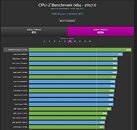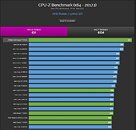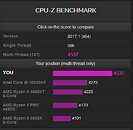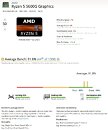Thursday, May 6th 2021

AMD Ryzen 7 5700G and Ryzen 5 5600G "Zen 3" Cezanne Desktop Processors Benched
Several benchmark numbers of the upcoming AMD Ryzen 7 5700G and Ryzen 5 5600G desktop processors were fished out by Thai PC enthusiast TUM_APISAK. The 5700G and 5600G are based on the 7 nm "Cezanne" silicon that combines up to 8 "Zen 3" CPU cores across a single CCX, sharing a single 16 MB L3 cache; along with an iGPU based on the "Vega" graphics architecture. Both chips were put through the CPU-Z Bench, where they posted spectacular results.
Both chips post higher single-thread score than the Core i9-10900K "Comet Lake," riding on the back of the high IPC of the "Zen 3" cores, and low latencies from the monolithic "Cezanne" silicon. In the multi-threaded test, the 8-core/16-thread 5700G scored above the Core i9-9900KS (5.00 GHz all-core). An HP OMEN 25L pre-built was put through Geekbench 5, where it was found performing within 90% of the Core i5-11600K. Userbenchmark remarks that the 5600X performs within the league of contemporaries, but falls behind on memory latency. Find the validation pages in the source links below.
Sources:
TUM_APISAK (Twitter) 1, TUM_APISAK (Twitter) 2, 5600G CPU-Z Validation, 5700G CPU-Z Validation, 5600G Geekbench 5, UserBenchmark 5600G, UserBenchmark 5700G
Both chips post higher single-thread score than the Core i9-10900K "Comet Lake," riding on the back of the high IPC of the "Zen 3" cores, and low latencies from the monolithic "Cezanne" silicon. In the multi-threaded test, the 8-core/16-thread 5700G scored above the Core i9-9900KS (5.00 GHz all-core). An HP OMEN 25L pre-built was put through Geekbench 5, where it was found performing within 90% of the Core i5-11600K. Userbenchmark remarks that the 5600X performs within the league of contemporaries, but falls behind on memory latency. Find the validation pages in the source links below.






35 Comments on AMD Ryzen 7 5700G and Ryzen 5 5600G "Zen 3" Cezanne Desktop Processors Benched
Any other comparisons are pretty irrelevant since there's nothing new here, it's just a reduced-cache version of Vermeer with some dated 2017 Vega cores glued onto the side.
The interesting parts will be the 15W parts, as the vega IGP is a 100% waste of silicon for those "desktop socket" laptops that always have a dGPU.
OEMs might try to pass these off as alternatives to buying a system with a hard-to-find GPU but they're not cheap, and something that's leagues better than the IGP can be had for cheap because miners are only driving up the price of 4GB+ GPUs. You can pick up an RX550 2GB for £/€/$90 new, 60 used with ease, and that's not even the best option.
I'm surprised to see such an uplift over the 4750g! I just bought that chip for an SFX system and it's blowing me away how good it is, if the 5700g is even better.... May need to upgrade in the future if the silicon shortage eventually goes away and prices become sane again, it will be more than enough for me until DDR5 systems become more mainstream in a few years.
skatterbencher.com/2021/04/27/skatterbencher-24-amd-ryzen-7-5700g-overclocked-to-4850-mhz/
And even got from it myself when I tried it.
I'll wait for the real, reliable benchies to be ran with these chips before making a decision about them.
What makes you think it will be $350? The 5600G might be $350 because that's only $50 more than the 5600X.
AMD are not going to cannibalise their own profits by selling an 8-core part with graphics for less than any other 8-core part of the same generation. The 5700 sells for around $440 and that doesn't have integrated graphics. Expect the 5700G to cost around $25-75 more than that. History proves that AMD typically charges $20 premium and real-world street pricing on these rarer APUs drove that premium up much higher than that, with lack of retail boxes leaving pricing at the mercy of botique builders who happened to sell CPUs seperately. Renoir APUs were never sold as retail-boxed units in the retail channel.
This is a large, monolithic die. It is significantly more expensive to make than the 8C/16T chiplet of the 5800X. If the 5700G doesn't cost at least $450 I'll be amazed.
Controversy is about their Effective speed number and weights of benchmark results with different core counts they use to calculate that. So their rankings and Effective speed stuff is crap.
Benchmark results themselves are fine. They give a pretty good indication of different performance aspects - of a CPU in this case. In a tech-minded community like TPU looking at those should be OK.
5700G gets about the same single-core perf as 5800X, better results from 4-core (4%) and 8-core (+12%) but again 5% slower in 64-core test. The last part is probably TDP and power limit showing up.
For some reason 5700G seems to lag behind 5800X in memory latency though. Interesting.
the 6 core will go nicely with the less than stellar B550 MB/RAM I have kicking around.
Always assuming one can be found.Amazing how opinions change.
Lots of people here constantly criticise AMD CPUs' for their lack of an IGP-particularly with the current shortage of even half decent GPUs'-
and here is AMD providing a CPU with a much stronger IGP than anything Intel offers and there's still criticism.
Renoir is 156 mm², Cezanne is bigger - best guess for now based on dieshot/diagrams is ~175 mm². Monolithic 7 nm chip, more than twice the size of Zen3 CCD.
Show me real world game benchmarks against an R5 3400G and the price.
The larger the die area, the more wafer it uses, so the fewer chips you get per wafer, which pushes up the price by a squared relationship (because area increases as a square relationship, not a linear releationship).
Ignoring that first exponential cost increase there's still the issue of yields; the chance of a die being defective increases exponentially with area becuase area increases as a square whilst defects per area is a linear constant.
Ignoring that second exponential cost increase there's the third issue of edge wastage. the larger a die, the larger the "steps" around the edge of the circular wafer that don't fit a whole die. The only way to fit a square peg into a round hole is with gaps, and those gaps are unsellable, wasted (but expensive) silicon wafer.
So, as the transistor count of a CPU increases linearly, you have two seperate exponential increases to multiply by, and than another linear cost increase on top of that. Big chips are super expensive.
Using any of the available semiconductor yield calculators, you'll be able to see that AMD can have either ~300 8-core Zen3 chiplets out of a wafer, or ~130 8 core APUs out of the exact same wafer. Whatever they choose to charge for it, the APU silicon is (300/130) about 2.3x as expensive for them to make. We're lucky AMD only charge a small premium for their APUs because 2.3x the cost of a Ryzen 7 5800 is a thousand dollars.
Above is Zen2 8C/16T vs Renoir 8C/16T. AMD actually get more than twice as many Zen2 chiplets for the same money. Even ignoring the exponents, the sheer die area increase alone is enough to cause significant cost increases of the end product. AMD pay TSMC the same per wafer and the same to run that wafer through the fab no matter what product they etch into that wafer. Put yourself in AMD's shoes and ask yourself if you want to sell 780 products per wafer at $450 each or 322 products per wafer at $470 each? It's okay, I'll wait....